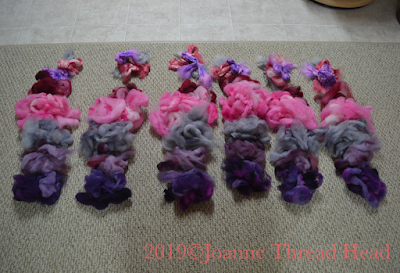Last week I finished combing another raw fleece, from a local farmer. This one was over 700g after washing.
The sheep are a cross, but mainly Down breeds (Southdown and Dorset Down) - named for region of England they originate. The fleece exhibits the typical characteristics of the breeds - crimpy locks, lofty and resistant to felting. I have been very lucky to have had the chance to work with these fleeces, and this year I want to experiment more with them (usually I just clean, comb and spin the fleece into lovely yarn).
After a bit of reading I discovered that the best way to prepare this type of fleece for spinning is by carding, so this post is about that experience.
I did start by combing the cleaned fleece, to remove most of the vegetable matter (carding would just break up the VM, but not remove it). Combing also gets rid of the short cuts and nepps.
The bag on the left is the prepared wool - 387g. The bag on the right is the 'waste' - almost 50% of the fleece, pretty typical for the breed I have read (it didn't go to waste, this was stuffed into and old pillowcase and used to make a little cat bed).
This particular fleece was really fine (compared to others I have spun), so I decided that I would make a sweater with it.
For this yarn I decided to combine the wool with a bit of yak for fuzz, and some silk for shine, for a 83% wool, 11% silk and 6% yak blend.
I dyed the fibre before carding (the first time I have dyed this fibre before spinning).
After weighing out each colour I divided the fibre into six piles.
I chose six because my drum carder holds about 100g and I wanted an even number since I am making a two ply yarn and I knew that I would be adding different add ins to each ply.
I started by adding the fibre to the drum carder (each batt was about 80g).
After the first pass I then passed them through the drum carder (this is an Ashford wide drum carder) two more times. I tore the batt into pieces and spread them out across the layers before putting them back in the drum carder (you can see the shiny silk in the above photo).
For three of the batts (or one of the plies) I added some dyed raw silk to the large drum during the last pass. The other three batts had a pinch of silver angelina added during the first pass (I couldn't resist a bit of sparkle).
The above photo shows the dyed fibre, the initial pass, the second pass and the final batt. With three passes it was quite well mixed, but you could still see individual colours and fibre types.
I dizzed the fibre off the batt ready for spinning (dizzing is just pulling the fibre through a button, essentially pre-drafting).
The little bundles ready for spinning - the ones on the left have the sparkle and the ones on the right have the gold coloured raw silk. I made sure to prepare and mix up the bundles for each of the plies before spinning in case there were differences in colour between the batts.
Carding adds lots of air to the fibre and for spinning I made sure to keep as much of the air in as possible by using a short backwards draft and letting the spin enter the fibre bundle.
It created a real woolen spun yarn (lofty and light, as opposed to a worsted yarn that has most of the air removed and is denser - the yarn I spun in last weeks post for socks was a worsted yarn).
I am really pleased with the colour - it is a nice heathered, tweedy yarn with a hint of sparkle.
It puffed out a bit after washing and came out to about a DK weight yarn. I don't usually sample, but I wanted to make sure that I would be happy with the final product before spinning all the fibre.
The knitted sample is really soft (I think I will be able to wear it on my bare skin) and squishy/bouncy, with a nice drape and a little bit of a halo from the yak - I think it is going to make a beautiful sweater.
 |
| sunrise |
 |
| the full moon before sunset last night (and before the lunar eclipse) |
 |
| she looks so angry |


















